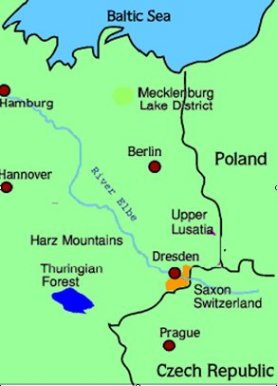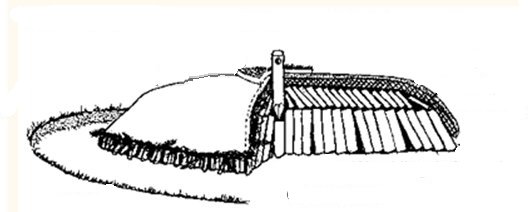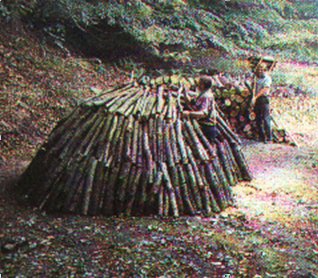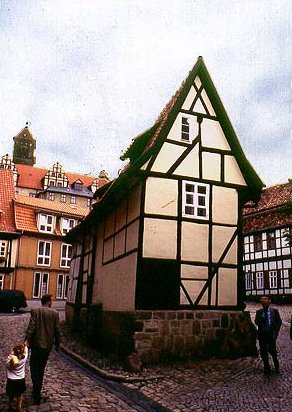The TOPPERWIEN Family History
Click here to view the TOPPERWIEN Family Tree,
Click here to view the FOX - TOPPERWIEN Family Tree,
|
The connection between the NEWMAN family
and the TOPPERWIEN family was made when Dina NEWMAN married Eldon
FOX whose mother was Ivy May TOPPERWIEN.
Some Topperwien Background History
|
|
The Topperwien family came from the Lanau in the Harz
Mountains in eastern Germany where they had lived for many
generations. Some years ago I was in correspondence with a
member of this family, Annemarie Topperwien, who still lived in
Germany although not in the same area as her ancestors. She sent
me the following piece of writing which was written by her
father-in-law, Heinrich Ernst August Topperwien (born 8th
November 1892, Hertzberg, Germany - died 3rd October 1956,
Solingen, Germany) who was the son of Heinrich Karl Topperwien
and Friederike Soffker. Both men seem to have been known by
their last forenames, August and Karl. The grandmother he speaks
of would have been Dorothee Benhausen.
|

|
Map showing the Harz Mountains where the Topperwien
family lived for many generations.
|
|
EXTRACTS FROM AUGUST TOPPERWIEN'S NOTICES IN THE FAMILY
BIBLE
Translated from the German by Anna Fuchs.
In the middle of the 17th century the iron ore industry in Lonau
came to a standstill [the Thirty Year's War]. In 1667 things
were set in motion again in Lonau. After 1732 the iron smelting
industry centred more on Andreasberg. In 1766 the industry
finally closed down at Lonau but the Lonau foundry (near
Hertzberg) continued to function. It is the latter that must
account for the description of Conrad Topperwien as "coal worker
at the iron works" in 1809. In the village the only sources for
making a living that remained were charcoal burning, timber
felling, animal husbandry and arable farming on a subsistence
level.. Toward the end of the last century coal mining and the
railway almost completely destroyed the charcoal burning
industry. Herman August Topperwien (1833-1892)
[see Topperwien Family Tree] was the last of the
family still to have been employed as a charcoal burner in his
younger years, as from the last third of the last century the
more able of the village youths sought their living and their
fortune in increasing numbers in the wider world; this was also
the case of Karl Topperwien (1861-1903).
Our ancestors have been iron workers, respectively charcoal
burners, since the beginning of time, i.e. for about 300 years.
My great-grandfather and my grandfather were charcoal burners.
The tradition passed down leads to the conclusion that even our
ancestors before these were charcoal burners rather than iron
mine workers. Apart from this at least as long as they lived in
Lonau, they were also small-scale peasants owning about half a
dozen Morgen [about 0.9 acres] of fields and meadows. The work
of looking after the land and the animals was largely left to the
mother and the older children. The husband would only stay at
home when it came to planting the potatoes, to mowing, to lifting
the potatoes and to killing the pigs. Fr. Gunther in his book
"Harz", 1910 gives an excellent description of the trade of
charcoal burning.
|
"While the forestry workers will spend at least one night a week
under the same roof as their families the charcoal burners will
only see their village on very special occasions during the whole
of the summer, half of the year, because the charcoal kilns will
burn on Sundays as much as during the rest of the week. But once
a week the charcoal burner's wife will be on her way with her
wicker basket in order to bring bread, something to eat with the
bread and other supplies to her husband. Since one master's
charcoal clearing usually consists of four to six kilns that are
kept working at any one time but are at different stages, one
visit at one of the clearings will suffice to become acquainted
with all the work of the charcoal burning industry! - Here we are
watching the erection of a kiln: Two poles form the centre of a
circular `coal area', round pieces of timber are placed around
them almost vertically, layer by layer, in such a way that an air
shaft is left between the poles right down to the ground and down
on the ground there remains a horizontal air shaft. In another
place assistants are busy covering a completed kiln construction
about 3 meters in height with twigs and grass and also with a
whole lot of earth and coal dust. Once the kiln is ready the
charcoal burner (master) will set it alight by means of a
folded-up, resin-filled piece of bark that he inserts, with the
help a stick, through the air shaft into the pieces of wood in
the middle of the kiln.
|
|

The construction of a charcoal kiln
|
Several kilns are already burning away.
The one with the white-greyish smoke was lit only the day before
yesterday, another one, blue on all sides, has reached the stage
at which the charcoal is already `fermenting'. The control over
the fire, `governance of the fire', is the charcoal burner's
special skill. Quite frequently he has to re-route the wind
shafts and create draft holes on the leeward side of the kilns.
At other times he has to repair cracks in the kiln's covering as
the fire keeps wanting to burn the coverings. For this purpose
he uses a long pole or he will try to heal the cracks by means of
covering them with pieces of turf. The charcoal burner cannot
relax either day or night and - like the captain of a ship - he
has to divide up the time into `watches'.
|
|

A charcoal kiln in the forest
|
It is a real pleasure to watch the filling up of the burning
kilns in the evenings. You can see the sooty figures enveloped in
smoke, by the light of the brightly burning glow of the coal, as
they handle their material most vigorously on top of the kilns.
For a whole week the kilns must be refilled with wood each day
to the extent to which they have burnt down. The charcoal burner
will lay his `steps' consisting of a thick, long log with
carved-in footsteps against the kiln, he will climb up these
`steps', will shovel away the covering from the sunk-in lid, will
push down the coal with his long pole, will hammer in the wood
that his assistants pass up to him, will then replace the lid
protecting it with further coverings (of ashes and twigs and
moss). All this has to be completed as quickly as possible,
since the longer the kiln is allowed to burn away in the open the
more of the coal will turn to ashes. When the coaling process is
completed the kiln will turn into one glowing mass, a
terrifyingly beautiful sight in the dark night.
The charcoal burner's hovel, his living quarters, is not unlike
that of the forestry worker. Young spruce of the thickness of an
arm are knocked into the ground forming a circular shape. They
are bent at the top to make a conical shape and are covered with
large pieces of bark on the outside, the gaps on the inside are
plugged with moss. A low opening with a small overhang serves as
both door and window; in the middle of this hovel a stone
construction makes a fireplace and there are benches all around
this standing close against the wall. Covered with pine twigs
and moss these benches also make up the sleeping quarters, the
master on the right, his assistants on the left and the boys
somewhere in the background. Several small cupboards contain the
eating provisions. In the evenings the tired workers will camp
around the crackling fire whose smoke tries in vain to escape and
they will prepare their beloved charcoal-burner's soup consisting
of slices of bread, water, salt, pepper and butter; they will
complete their meal with bread and sausage and a sip of brandy.
After this they will make up the fire once more, close the door
and soon it will only be the breathing of the sleepers that will
intercept the silence and loneliness of the forest.
The `Hillebille' (alarm), a beech plank and a wooden hammer fixed
between two trees, that in the old days used to serve the
charcoal burner to assemble his comrades for meals from distant
kilns and also as an alarm signal to gather all men of the same
trade from considerable distances has not been in use for a long
time.
The charcoal burner whose loneliness is usually shared by a
shaggy dog is on the most friendly terms with the animals of the
forest. The shy deer will play happily within his vicinity and
the careful stag will trot through the smoke of the kiln without
special concern."
|
|
|
The Topperwien House.
The oldest house known to have been
inhabited in Lonau by a member of our family was the one directly
on the left of the church, building No 75. It was still
inhabited by Heinrich Christoph Topperwien (1752-1817). The
third of the building facing the church was only added in the
eighties of the last century. Ever since the days of Heinrich
Christoph's son, Heinrich Conrad (1788-1871), our family has been
living in `am Wasser', that is by the Lonau [River], house No 21.
The author (of these extracts) spent almost all his holidays in
that house until the death of his grandmother (1908), his Lonau
playmates would, therefore, call him `water August' (as in fact
his father had always been nicknamed `water Karl'.
|
|

Typical village houses in the Harz Mountains
|
He maintained the peasant style of the house, in inextinguishable
memory; the back of the house (with sturdy settee, the simple
blue food cupboard on the inside of the door of which the
grandmother had noted important dates in chalk, with the table
that contained a box for the preparation of cheese below its
removable top); the living room in which he so often sat with the
grandmother taking the evening meal by the light of the paraffin
lamp and then listening to the hum of the spinning wheel and
trying to get the laconic lady to talk about old times - and on
one occasion, but on one occasion only, he got the hard, surly
lady to sing a song from the time of her youth `In des garten
dunkler Laube', the Sunday-room, in which the sun's rays would
play all day long on the broad planks of the painted floor and on
the strong polished surfaces of the ashen furniture and in which
unending fascination was exercised by the clock case that
contained grandfather's construction books and other rarities
(new year's pistol, old knives, etc., etc.) by the old pictures
of relatives above the sofa; the lumber room upstairs with the
home made lute that belonged to a musical great-uncle who died
young (Ernst Ludwig) and with grandfather's false teeth; the
baking room in the adjoining bake-house into which the father
when a boy would retire with his violin in order not to burden
the grandmother with his `silly noise'; the attic below the
boarded tiled roof which contained all sorts of old pots to
collect the rain that seeped through in various places when the
weather was wet (grandmother could not be persuaded to prevent
the greatest part of the damage by having a few new tiles put on
the roof), the deep vaulted cellar lit by two holes in the wall,
the mice's abode (grandmother did not own a cat, probably because
she resented having to give up some of the milk to the animal),
access to which was by a completely dark, stone staircase without
handrail and in whose entry there stood a dusty little bottle
that father had filled with Easter Water from the Lonau some time
in the sixties; the little garden on the slope between the house
and the brook with its ancient, tempting pear tree and the wild
hop whips; the village brook whose rushing noise would send the
boy to sleep in the evening and wake him up in the morning; the
steep, high meadow behind the house with its path from which the
talented, adventurous great uncle, Heinrich Philipp, the joiner,
waved for the last time when on his way to Osterode in order to
set off on his big voyage to Australia from there, never to be
seen again. Now the timber frame of the dear house that had been
blackened by age has been covered with wood all around and has
been painted and has acquired quite a different appearance. August Topperwien
* * * * * * * * * *
The Heinrich Philipp mentioned in the last paragraph is the
grandfather of Ivy May Topperwien and great grandfather of Eldon
Fox. Annemarie Topperwien in Germany also wrote to me the
following in 1995:- According to our family tree all news of him
[Heinrich Philipp] ends after this point, but there is one
wonderful Tobacco case on inlaid work made by him and
respectfully given from father to son for the last 100 years.
Until now we didn't know anything about this skilful craftsman.
That there is a considerable family [in Australia] too we learned
just now by your letter.
It would seem also from the mention in the above account of the
handmade lute and the violin with its `silly noise' that the
grandmother did not like, that there has always been an interest
in and love of music in the Topperwien family. This has been
carried on now in almost every branch of the Australian
Topperwiens.
|




